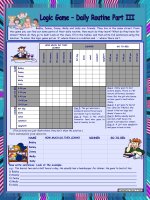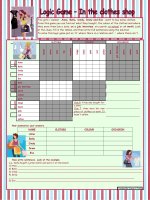12065 logic game 33rd best friends elementary with key with stepbystep instructions
Bạn đang xem bản rút gọn của tài liệu. Xem và tải ngay bản đầy đủ của tài liệu tại đây (157.31 KB, 3 trang )
Anne, Brian, Cindy and David have got best friends. From this game you can find
out their best friends’ name, who they are and their age. Look at the clues, fill in the
tables, and then write full sentences using the solution.
To solve this logic game put an 'X' where there is a relation and '-' where there isn't.
MENA
10
9
8
7
FRIEND’S AGE
neighbour
family friend
cousin
classmate
WHO’S THE FRIEND
Ted
Marty
Lisa
Amy
FRIEND’S NAME
Anne
Brian
Cindy
ENFRI
David
7
8
9
O’SWH
10
classmate
cousin
family friend
neighbour
Now summarize your answers.
NAME
FRIEND’S NAME
WHO’S THE FRIEND
FRIEND’S AGE
Anne
Brian
Cindy
David
Now write sentences. Look at the example.
e.g.: Molly’s best friend is Lola, a girl from the playground. She is 6 years old.
1) Anne
____________________________________________________________________________________
2) Brian
____________________________________________________________________________________
3) Cindy
____________________________________________________________________________________
4) David
____________________________________________________________________________________
© Susan V Toth
SOLUTION
NAME
FRIEND’S NAME
WHO’S THE FRIEND
FRIEND’S AGE
Anne
Amy
neighbour
10
Brian
Ted
classmate
8
Cindy
Marty
cousin
9
David
Lisa
family friend
7
The cliparts are from fumira com.
The steps of the solution
If you put an X somewhere cross out the other rubrics in the same row and column but just in that part of
the table.
12
Lily
11
MENA
Kelly
10
AGE
9
e.g.
-
-
-
X
Rob
-
Tim
-
CLUE 1: David’s friend is a girl. She isn’t eight years old. She isn’t his cousin or his neighbour.
Step 1: David’s friend is a girl.
You can cross out (-) Marty and Ted in David’s row.
Step 2: She isn’t eight years old.
You can cross out 8 in David’s row.
Step 3: She isn’t his cousin or his neighbour.
You can cross out the cousin and the neighbour in David’s row.
CLUE 2: Marty is Cindy’s friend. He isn’t her classmate. He’s nine years old.
Step 1: Marty is Cindy’s friend.
You can put an X to Marty in Cindy’s row. You can cross out Amy, Lisa and Ted.
Of course you can cross out Anne and Brian in Marty’s column.
Step 2: He isn’t her classmate.
You can cross out the classmate in Cindy’s row and also in Marty’s column.
Step 3: He’s nine years old.
• You can put an X to 9 in Cindy’s row. You can cross out here 7, 8 and 10. In the column 9 you can
cross out Anne, Brian and David.
• You can put an X to 9 in Marty’s column. You can cross out here 7, 8 and 10.
• And you can also cross out Amy, Lisa and Ted in row 9.
Step 4: You can cross out one more thing in row 9. It’s the classmate. Because Marty isn’t Cindy’s classmate.
CLUE 3: The neighbours are girls.
• You can cross out Brian and Cindy in the neighbour’s column. Yes, Cindy, too. Because we know her
friend is a boy. So there’s only one name left. It’s Anne. So Anne’s neighbour is her best
friend. You can put an X to Anne in this column, and cross out the classmate, the cousin and the
family friend in Anne’s row.
• You can also cross out 9 in the neighbour’s column (because Marty’s 9 and he’s a boy). And you can
also cross out Marty and Ted in the neighbour’s row.
• You can cross out Ted in Anne’s row.
• Now you get Ted’s Brian’s friend. Put there an X.
• Cross out Amy and Lisa in Brian’s row.
CLUE 4: Lisa is a family friend.
•
Put an X to the family friend in Lisa’s column. You can cross out the classmate, the cousin and the
neighbour. You can also cross out Amy, Marty and Ted in the family friend’s row.
•
You get that Amy is a neighbour. Put an X there. Cross out the cousin and the classmate in Amy’s
column.
•
Now you get that Ted is the classmate and Marty’s the cousin. Put there X. Cross out the cousin
in Ted’s column.
•
Use these pieces of information to fill in the other parts of the table. Let’s see how.
o So Ted’s the classmate and he’s Brian’s friend, too. That’s why we can put an X to the
classmate in Brian’s row and cross out the cousin and the family friend. Also we can cross
out David in the classmate’s column.
o We get that Cindy’s friend is her cousin. Put there an X. Cross out the family friend in her
row.
o And also we know now David’s friend is the family friend. Put there an X, as well.
•
The next step is to match the pieces of information we know.
o The neighbour is Amy and Anne’s friend is the neighbour. So Amy is Anne’s friend. Put
there an X. And cross out Lisa in Anne’s row and David in Amy’s column.
o There’s only one possibility, Lisa is David’s friend, so put an X to Lisa in David’s row.
She’s very young.
• Put an X to 7 in Lisa’s column (because very young means the youngest here) and cross out 8 and
10. Also cross out Amy and Ted in the row of 7.
• Lisa is David’s friend, so put an X to 7 in David’s row. Cross out 10. Also cross out Anne and Brian
in the column of 7.
• Lisa is a family friend, so put an X to the family friend in the row of 7. Cross out here the
classmate, the cousins and the neighbours. Also cross out 8, 9, 10 in the family friend’s column.
• There’s only one possibility in the row of 9, so put an X to 9 in the cousin’s column and cross out 8
and 10.
CLUE 5: Ted isn’t ten.
• Cross out Ted in row of 10. We get that Amy is 10. So put there an X. Cross out 8 in Amy’s column.
We get that Ted’s 8. Put there an X.
• Finally, put an X to 10 in Anne’s row and another one to 8 in Brian’s.
• Put an X to the classmate in row of 8 and one more to the neighbour in the row of 10. Cross out
the left rubrics.
We are ready. You can fill in the chart / table with the pieces of information and write down the sentences.









